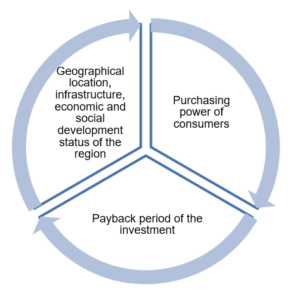GRATA International Mongolia Law firm | View firm profile
Background
Mongolia’s total renewable energy potential is 2600 gigawatts (GW), over 1000 times larger than the 1.6 GW installed capacity of Mongolia’s electricity system[1].
In the decades ahead, this potential could be harnessed through the vast solar and wind resources of Mongolia’s Gobi Desert. With the effective development of energy transmission infrastructure, these resources could not only meet domestic energy consumption but also fulfill the energy demands of the Northeastern Asian region. Despite its vast renewable energy potential, Mongolia currently depends on coal-fired thermal power plants for about 90 percent of its electricity production. Coal is also the primary source of heating. As a result, the energy sector is the major contributor to significant greenhouse gas emissions and severe air pollution in the country. The amount of electricity produced in Mongolia in 2023 was about 8528 million kWh, an increase of 3.3% or 349.7 million kWh over the year before. The majority of electricity produced, 90.9%, came from combined heat and power plants; the remaining 8.5% came from solar and wind power, 0.6% from hydropower sources, and 0.01% from diesel generators. In addition, the amount of power imported during the reporting period was 2447.6 million kWh, which represents a 13.2% increase over the previous year by 286.3 million kWh.[2]
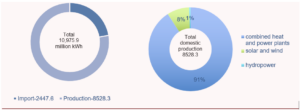
Therefore, Mongolia is taking concrete actions to increase development and investment in its renewable energy sector. In particular, Mongolia amended the Renewable Energy Law in 2008, 2011, 2012, 2015, 2019, and 2022, adding key provisions to support renewable energy projects. These amendments include the introduction of feed-in tariffs, a competitive auction system for renewable energy projects, project implementation guarantee and other supportive measures.
Mongolia’s climate commitments under International Agreements
Mongolia has shown a strong commitment to supporting the ultimate goal of the United Nations Framework Convention on Climate Change (UNFCCC)—limiting global warming to well below 2°C, and pursuing efforts to limit it to 1.5°C —through the following actions:
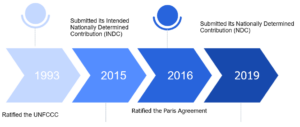
In September 2015, Mongolia adopted its first Nationally Determined Contribution (NDC) to the UNFCCC, committing to reduce greenhouse gas emissions by 14% by 2030. In 2019, Mongolia updated its NDC target to 22.7% by 2030. This target includes reducing carbon emissions from the energy production and supply sector by 8.34 million CO2-equivalent (CO2-eq) tonnes and reducing carbon emissions from renewable energy by 2.97 million tonnes CO2-eq[3].
To achieve this international commitment, Mongolia is actively working to increase the share of renewable energy in its total installed energy capacity, including wind, solar, and hydropower. It has developed and adopted key state policy documents, such as “Vision-2050” and the “2021 New Recovery Policy.” Specifically, Vision-2050, the country’s long-term development strategy approved by Parliament in 2020, reflected the government’s target to increase the installed renewable energy capacity to 30 percent by 2030[4].
Amendments to the 2007 Renewable Energy Law to Support the Renewables
Tariff change and feed-in tariffs
The provisions for renewable energy tariffs were amended in 2015 and 2019. These amendments replaced the previous tariff system, which included minimum (floor) and maximum tariffs, by introducing a cap on renewable energy tariffs without establishing a minimum tariff.
| Energy Source | On-Grid Tariff (USD/kWh) |
| Wind | up to 0.085 |
| Hydropower (up to 5 MW) | 0.045 – 0.06 |
| Solar PV | 0.12 |
The Energy Regulatory Committee(hereainfter “the ERC”) reviews and approves energy price calculations, sets tariffs within the specific limits above, and monitors agreements between producers and the National Dispatching Center. The National Dispatching Center is responsible for purchasing electricity from producers at approved tariffs and managing grid expansion, excluding the connection of producers to the transmission grid. The National Power Transmission Grid is responsible for connecting the transmission line from the renewable energy plant to the grid, which is built and paid for by the developer.
The tariff limits are determined based on the payback period of the investment to ensure that renewable energy projects remain financially viable, encouraging investment in clean energy infrastructure while avoiding undue financial burden on consumers.
The difference in the price of electricity produced by renewable energy producers connected to the transmission grid shall be compensated through feed-in tariffs, as stipulated in Article 11 of the Renewable Energy Law. Feed-in tariffs (FiTs) are a policy mechanism used to promote the development of renewable energy projects by guaranteeing a fixed payment to energy producers for the electricity they generate. These tariffs are designed to provide financial incentives to renewable energy producers by offering long-term contracts at stable, often above-market prices, which encourage investment in renewable energy infrastructure.
Factors for determining the prices and tariffs
Competitive procurement of renewables
Renewable energy projects for constructing generators connected to the grid will compete for selection based on established technical criteria and price offers. The procurement process will be conducted through an auctioning system by the Ministry of Energy. Project selection involves the following stages[5], as specified in the Regulation for Competitive Procurement of Renewables:
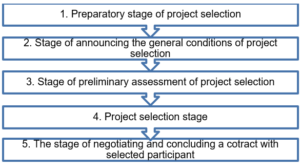
Principles for organizing the project selection
| Principle | Description |
| State Policy Compliance | The project must align with the state’s renewable energy development policy and support the sustainable operation of the integrated energy network. Key factors such as project location, power source type, installed capacity, and annual power purchase amount should be determined in advance. |
| Competitive Pricing | The project must demonstrate competitiveness in terms of selling price, as well as the renewable energy equipment and technology to be deployed. |
| Transparency, Fairness, and Equality | The project selection process should ensure transparency, fairness, and equality. |
Obtaining a special permit and project implementation guarantee

A project implementation guarantee means funds deposited in the bank and a bank guarantee submitted by a project participant confirming the full implementation of the project. It ensures that developers meet their obligations and complete the construction of the plant on time. This guarantee must clearly be outlined in the power purchase agreement between a renewable energy producer and a National Dispatch Center according to the law.
Taxation and non-taxation Incentives and Exemptions for Renewable Energy Production and Equipment for investors
To encourage domestic and foreign investment in renewable energy production, research, development, and infrastructure, the following tax and non-taxation incentives are provided:
Tax Incentives
| Incentive Type | Details | Tax Rate |
| Customs and VAT Exemptions | Machinery and equipment for renewable energy research, development, and production | 0% VAT; Duty Exempt |
| Corporate Income Tax (CIT) Incentives | Sale of environmentally friendly equipment | Reduced tax rate |
| Investment income from energy sources in free zones (USD 500,000+) | 50% tax reduction | |
| Income from heat/electricity projects after 2023 (first 3 years) | 90% tax reduction | |
| Income from heat/electricity projects after 2023 (next 3 years) | 50% tax reduction | |
| Income from equipment production for >5 MW (electricity) or >1.5 MW (thermal) sources | 90% tax reduction |
Non-Taxation Incentives
| Incentive Type | Details |
| 📋 Operational Flexibility | Simplified processes in free zones and technology parks to reduce administrative burdens |
| 👨💼 Workforce Support | Increased quotas for foreign specialists, exemption from fees, and faster permit approvals |
| 💼 Investment Guarantees | Government assurance for funding innovative export-oriented projects in manufacturing |
| 🛂 Visas & Residency | Easy access to multiple-entry visas and residency permits for investors and their families |
| Year operational | Project name | Power owner | Capacity
(MW) |
Investment
(million USD) |
Key International public lenders |
| Wind farms | |||||
| 2013 | Salkhit | Clean Energy | 50 | 122.1 | EBRD, FMO |
| 2017 | Tsetsil | Clean Energy Asia | 50 | 120.7 | EBRD, JICA |
| 2018 | Sainshand | Sainshand Salkhin Park | 55 | 121.7 | EIB, EBRD |
| Subtotal | 155 | 364.5 | |||
| Solar plants | |||||
| 2016 | Nar (Darkhan) | Solar Power International | 10 | 18.3 | Joint Crediting Mechanism |
| 2017 | Monnaran | Everyday Farm | 10 | 23 | JBIC |
| 2018 | Gegeen | Naranteeg | 15 | 26 | 100% Equity |
| 2019 | Sumber | ESB Solar Energy | 10 | 17.6 | GCF |
| 2019 | Bukhug | Tenuungerel Construction | 15 | 18.7 | ADB |
| 2020 | Gobi | Desert Solar Power One | 30 | 30.7 | EBRD, FMO |
| 2022 | Khovd Nar (Myngad) | N/A | 10 | 16.0 | World Bank |
| 2023 | Borkh | MCS International | 5 | 7.95 | ADB |
| 2023 | Serven | MCS International | 10 | 10.4 | ADB |
| Subtotal | 115 | 168.65 | |||
| Total | 270 | 533.15 |
Current ongoing renewable energy projects
The renewable energy projects attracted a significant investment in wind and solar energy generation in recent years, totaling 270 MW of installed capacity with an investment of 533.15 million USD. The projects have been supported by key international public lenders, such as the EBRD, FMO, EIB, ADB, and the World Bank, demonstrating strong international collaboration in the development of Mongolia’s renewable energy sector. The wind farms account for 155 MW of this capacity, while the solar plants contribute 115 MW.
The current projects on renewable energy has been shown on below table: [6]
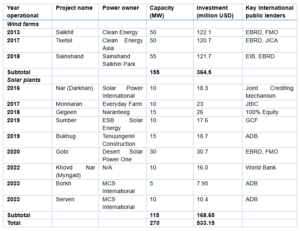
Investment opportunities in Mongolia
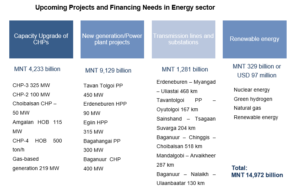
References:
- Law of Mongolia on Renewable Energy (2007)
- Law of Mongolia on Investment (2015)
- Law of Mongolia on Corporate Income Taxation (2019)
- Law of Mongolia on Value-Added Taxation (2015)
- Law of Mongolia on Custom Tariffs and Custom Duties (2008)
- Action plan for 2021-2030 of Mongolia’s long-term development policy “Vision-2050 https://legalinfo.mn/mn/detail?lawId=211058&showType=1
- Regulation for Competitive Procurement of Renewables https://legalinfo.mn/mn/detail?lawId=211075
- Nationally Determined Contribution (NDC) Targets of Mongolia – https://legalinfo.mn/mn/detail?lawId=14843
- Solar and wind power in Mongolia, 2024 Policy overview by Stockholm Environment Institute – https://www.sei.org/publications/solar-wind-mongolia-2024-policy/
- Comparative Policy Analysis of Renewable Energy Expansion in Mongolia and Other Relevant Countries – https://www.mdpi.com/1996-1073/17/20/5131
For further information, please contact V. Bolormaa, GRATA International Law Firm Partner at [email protected], and Junior Associate Kh.Enkh-Uchral at ekhurelbaatar@gratanet.com or +976 70155031.
GRATA International in Mongolia is part of the global law firm, which has offices in 20 other nations. This legal material is not a thorough examination of any particular problems; rather, it is meant to provide general knowledge. Before making any decisions, the reader should consult a professional for advice that is suitable to their situation (s). Any consequences or damages resulting from the use of this legal information are not our responsibility.
[1] Solar and wind power in Mongolia, 2024 Policy overview by Stockholm Environment Institute
https://www.sei.org/publications/solar-wind-mongolia-2024-policy/
[2]Comparative Policy Analysis of Renewable Energy Expansion in Mongolia and Other Relevant Countries
https://www.mdpi.com/1996-1073/17/20/5131
[3] Nationally Determined Contribution (NDC) of Mongolia for the Implementation of the Paris Agreement
https://legalinfo.mn/mn/detail?lawId=14843
[4] Action plan for 2021-2030 of Mongolia’s long-term development policy “Vision-2050 https://legalinfo.mn/mn/detail?lawId=211058&showType=1
[5] Regulation for Competitive Procurement of Renewables
https://legalinfo.mn/mn/detail?lawId=211075
[6] Solar and wind power in Mongolia, 2024 policy overview by Stockholm Environment Institute
